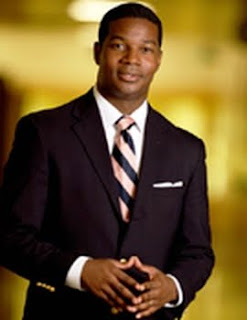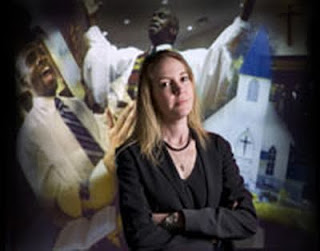California's anti–gay marriage intitiative Proposition 8 ignited a debate within Los Angeles' African American gay and lesbian communities: Should black same-sex couples come out to family and friends to help garner support for gay marriage, or should they continue to take a "don't ask, don't tell" approach?
"Some in the community were becoming more supportive of gay sexuality as an identity status that could exist alongside a strong racial-group affinity. Others were holding fast to religious and cultural ideologies that reduced gay sexuality to an immoral behavior and thus not a valid identity status," says Mignon R. Moore, a UCLA sociologist and professor of African American studies whose research — along with the work of more than two dozen other scholars — appears a new book that sheds light on black Los Angeles.
"Black Los Angeles" is the culmination of eight years of research the center conducted on African American communities in the region.
Hunt and Ramón were motivated to edit the book because they noticed a dearth of research that connected the dots between the past, present and future of black life in the Los Angeles. They met with scholars and community members to discuss what topics the book should include and then enlisted 23 experts to contribute chapters for the book.
"The chapters are interconnected by themes such as political participation, social justice, religious life, cultural production, and communities and neighborhoods, while individually featuring in-depth analyses of an issue or an episode in black Los Angeles," Ramón says. "We are proud to present a book that is both accessible and relevant to community members, students and scholars."
In the book's "Space" section, which deals with the history and geography of African Americans in Los Angeles, Paul Robinson, a geographer and assistant professor at Charles R. Drew University of Medicine and Science, notes that when El Pueblo de Nuestra Señora de la Reina de Los Angeles — the Spanish town that would eventually become the city Los Angeles — was established in 1781, the majority of its original settlers (26 of 46) had African ancestry.
These original settlers came from areas that are now states in western Mexico, a region where the Spanish empire relied heavily on African and mulatto populations as soldiers and laborers in agriculture and mining. By 2008, nearly 950,000 African Americans lived in Los Angeles County, making it home to the second largest number of African Americans in the nation.
Although 6 percent of black residents left the county in the 1990s, many in search of more affordable housing and a safer environment for their families, the population grew by 1 percent between 2000 and 2008, Robinson notes. Black immigrants from the Caribbean, Africa and the Americas are spurring the growth.
"The African-origin population of Los Angeles has always been diverse, but never as diverse as it had become by the first decade of the 2000s," Robinson writes.
By 2008, there were an estimated 90,000 persons of sub-Saharan and/or Caribbean ancestry living in Los Angeles County, constituting nearly 10 percent of the county's total black population.
"As the county's non-native population grew throughout the decade, the diverse groups comprising it increasingly challenged common assumptions about the people and spaces comprising 'Black Los Angeles,'" Robinson writes.
Reginald Chapple, former president and CEO of the Dunbar Economic Development Corp. and a UCLA doctoral candidate in anthropology, recounts the development of Central Avenue from 1900 to 1950 as a center of African American culture and of Leimert Park Village, the current black enclave. And Andrew Deener, an assistant professor of sociology at the University of Connecticut, examines the rise and decline of Los Angeles' only black community by the sea, Oakwood, in the Venice area.
In the book's "People" section, Jooyoung Lee, a sociologist and postdoctoral fellow in the Robert Wood Johnson Foundation's Health and Society Scholars program at the University of Pennsylvania, examines how some young black males in Los Angeles pursued careers in rapping as a means to economic opportunities that were otherwise absent in their communities.
Alex Alonso, a geographer and gang expert, writes about the influences that led to the rise of black gangs in Los Angeles. The ways in which black families cope with the incarceration of family members is explored by M. Belinda Tucker, a UCLA professor of psychiatry and biobehavorial sciences; Neva Pemberton, a UCLA doctoral candidate in education; Mary Weaver, executive director of Friends Outside in Los Angeles County; Gwendelyn Rivera, a UCLA doctoral student in education; and Carrie Petrucci, a senior research associate with EMT Associates Inc.
In the book's "Image" section, Nancy Wang Yuen, an assistant professor of sociology at Biola University, examines the lack of authentic roles for black actors in film and television; Paul Von Blum, a UCLA senior lecturer in African American studies and communication studies, writes about the rise of black art in Los Angeles after the Watts riots in 1965; and Scot Brown, a UCLA history professor, recounts the case of SOLAR, a black-owned record label that symbolized Los Angeles' rise as the media capital of black America in the latter decades of the 20th century.
The section also looks at the media attention focused on issues in the city's African American communities.
Hunt and Ramón, for example, examine Los Angeles Times' coverage of the controversial demise of Martin Luther King Jr./Charles Drew Medical Center. Dionne Bennett, an anthropologist and assistant professor of African American studies at Loyola Marymount University, writes about media misrepresentations of South Central Los Angeles and how certain films and television programs have contributed to stereotypical views of the area.
Interestingly, Bennett writes, residents had never referred to the area as South Central until the Watts riots of 1965. While there are various versions of how the term came to describe the area, it was officially used in the McCone Commission Report, a document that has been criticized for its superficial discussion of the complex events that shaped the riots, Bennett says.
"In the early twenty-first century, media images of South Central Los Angeles continued to label and limit African Americans," she writes. "These images usually omitted the educational, social and economic diversity of blacks not only in South Central, but throughout Black Los Angeles and ultimately Black America."
In the final section, "Action," Melina Abdullah, an associate professor of pan-African studies at California State University, Los Angeles, and Regina Freer, a professor of politics at Occidental College in Los Angeles, examine the rise of African American female leaders Charlotta Bass, a newspaper editor, publisher, activist and Progressive Party candidate for vice president in 1952, and former California Assembly Speaker Karen Bass, the first African American woman to serve as speaker of a state legislative body.
Sonya Winton, a political scientist and UCLA adjunct professor in African American studies, writes about a movement by the Concerned Citizens of South Central Los Angeles to halt construction of a municipal solid-waste incinerator plant in the 1980s. And Hunt and Ramón recount the efforts of the Alliance for Equal Opportunity in Education to spur UCLA to adopt a revised admissions policy after it was reported that fewer than 100 African Americans enrolled as freshmen in 2006.
The book also includes a chapter on labor issues authored by Edna Bonacich, a professor emeritus of sociology and ethnic studies at UC Riverside; Lola Smallwood-Cuevas and Lanita Morris, labor organizers and project directors with the UCLA Labor Center; Steven C. Pitts, a labor policy specialist with the UC Berkeley Center for Labor Research and Education; and Joshua Bloom, a UCLA doctoral candidate in sociology.
The authors discuss the lack of employment opportunities among Los Angeles' African American working-age population. In 2000, 43 percent were unemployed, while 29 percent were employed in low-wage, dead-end jobs that offered neither retirement nor health benefits.
"It must be noted here that immigrants were not to blame for the crisis in the African American community," the authors write.
While there was indeed job competition between working-class black Angelenos and immigrants, the authors explain that global restructuring, de-industrialization, flexible production and the contracting of services out to independent contractors, in addition to crack and criminalization, were more fundamental causes.
The authors call for a black worker center for Los Angeles, which would aim to increase union membership, participation and leadership among African American workers in the area.
"(The center) would serve as a place to develop ideas for building an alternative economic development plan for Black Los Angeles as a whole," the authors note.
For press copies of "Black Los Angeles: American Dreams and Racial Realities," please contact Letisia Marquez at UCLA Media Relations & Public Outreach at 310-206-3986 or lmarquez@support.ucla.edu.
By Letisia Marquez April 21, 2010 Media Contacts Letisia Marquez, 310-206-3986 lmarquez@support.ucla.edu
































